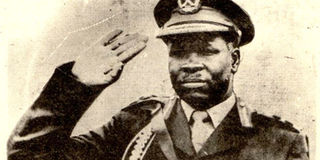What manufacturer says caused Gen Oyite-Ojok’s helicopter to crash

The General. Gen David Oyite-Ojok on of those days he was on duty before his demise. FILE PHOTO
What you need to know:
Anniversary. Last Sunday marked 35 years since the death of Maj Gen David Oyite-Ojok. The General was killed in a helicopter crash on December 2, 1983, in Luweero District. He was the chief of staff of the Uganda National Liberation Army (UNLA) at the time. Sunday Monitor’s Faustine Mugabe caught up with veteran politician, Aggrey Awori to explore Oyite-Ojok’s unpublished death report - The Bell August report.
The military helicopter, Augusta Bell Griffin, crashed, killing all occupants. The accident happened in the Luweero Triangle where the Bush War, led by now President Yoweri Museveni against the government of then president Milton Obote, was fought.
Speculation
The death of Oyite-Ojok bred several theories. Some said the crash was caused by a booby trap, others said it was a suicide mission aimed at eliminating the fearless general, while others claimed that Museveni’s National Resistance Army (NRA) rebels shot the helicopter down.
Because of that, the Obote government asked the helicopter manufacturer in the United States, Bell Augusta, to conduct an independent inquiry into the crash. Bell Augusta America was operated under an Italian franchise.
According to veteran politician Aggrey Awori, who was Uganda’s special envoy to Washington at the time, Bell Augusta conducted an investigation and filed two reports. One titled “confidential” was handed to president Obote and the other labelled “public” was given to other government officials. Awori delivered the two reports to Obote.
Bell Augusta report
Speaking to Sunday Monitor from his home in Busia District recently, Awori revealed the details of the report which have never been made public, 35 years later.
Awori, who had the opportunity to read through both reports, said he could only reveal details from the “public” report.
“I don’t want to get in trouble with Bell Augusta Company,” he says.
From the technical report by the investigators, Awori says, the cause of the helicopter crash was mechanical failure.
Details of why and how it happened were what led Bell Augusta to file two reports. They didn’t want to hide the cause, but also wanted to keep the incompetence of the army from the public eye. Thus the truth was revealed in the “confidential” report.
From what Awori remembers reading from the report, “the helicopter had gone to Kasese on an operation earlier in the day. It came back with a technical fault and the pilot complained of poor stability of the aircraft in the air”.
“He reported that its stability in the air could not be guaranteed. In other words, it could suffer ‘system failure’ as various parts of the plane were not coordinating.”

AGGREY AWORI- VETERAN POLITICIAN
“In this case, it was the rear rotor that was not functioning properly. On arrival, the pilot complained to the commander of the air force that the aircraft needed to be serviced. He suggested that it should be grounded.”
Instead, the commander ordered another pilot to fly the ill-fated helicopter.
According to the Lieutenant Okwanga’s flight book that was presented to the investigators, Awori says, the helicopter had returned from Kasese and landed at the Nile Mansions (now Kampala Serena Hotel) at about midday.
“But the chief of staff, the late Oyite-Ojok, wanted to go to Luweero to check on the operation against the NRA. He wanted to get there before sunset. And so, the option was to take the helicopter, notwithstanding the technical report that it was not airworthy,” the former Samia Bugwe North MP says.
“As a matter of fact, the commander of the helicopter who told the pilot that if he did not want to fly the helicopter, he would fly it himself never came back alive.”
System failure
Awori says from Lt Okwanga’s flight book, “It was discovered that certain parts of the aircraft were long overdue for overhaul, which confirms that there was system failure on the aircraft.”
“By the time the aircraft left the Nile Mansions, heading to Luweero, it had already developed problems. Since the commander of the Air Force was also the commander of the aircraft, we do not know what he recorded in his flight.”
“Also, to prove that there was something technically wrong, the ADC to the late Gen Oyite-Ojok tried to jump out of the aircraft when it lost balance and his body was found far away from the crash site.”
“From the black box, it was also proved that there was system failure which dismisses the theory that the helicopter was shot down by the NRA.”
From investigations conducted around the scene of accident, it was discovered that there was a heavy item on the plane, probably a drum of fuel that was found on site.
Investigations also found that there was ammunition which exploded, proving that the aircraft was not shot down because the direction of the ammunition showed it was coming from within the aircraft.
“Why did the commander of the air force refuse to listen to the report by the pilot who brought the aircraft from Kasese? The aircraft had a problem, especially on take-off and it should have been grounded. These are administrative questions which the manufacturers asked. Why the senior officer defied such a serious proposal is a question that still remains today. What we don’t know is whether the chief of staff, Oyite Ojok, was informed that the aircraft was in a dubious technical condition. Whether he also ignored, or he was kept in the dark, we don’t know.”




